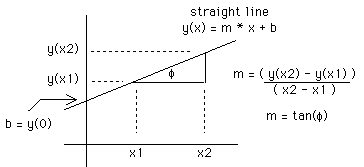



The equation of a straight line specifies the two basic characteristics of the line: the increase (decrease) of the function for an increase in x, and the position of the line in the x-y plane. The first characteristic is the "slope", or
m = Dy / D x = ( y(x2) - y(x1) ) / ( x2 - x 1 ) = constant.
The slope is geometrically interpreted as tan(f), where f is the angle the straight line makes with the horizontal x axis. A straight line is a function for which m = constant.

The slope m specifies the inclination of the straight line with respect to the x-axis. i.e., m>0 - line pointing "up", m<0 - line pointing "down", m=0 - constant.
The location of the straight line in the x-y plane can be specified by the intersection of the line with the y axis. The y value of the intersection is often labeled b, b = y(0). Given that m = constant, letting x 1 = 0 and simplifying the notation by using x = x2, yields y(x) = m * x + y(0), or
y(x) = m * x + b
If the horizontal axis is time, then the slope is often called a "rate". This concept is of primordial importance in all human endeavors. The speed at which you are driving is the rate of change of "position" with time (how many miles you are driving in an hour); a current is the rate of change of "electrical charge" with time; the income of a person is the rate of change of his/her "wealth" with time;. A gain or lost of weight is characterized by a rate (lbs per month). The US President's popularity is driven by a rate (increase or decrease of his popularity with time).
It must be clear to you that the slope (or the rate) need not be a constant; you are not "constantly" driving at 55 mph for instance. This says that the slope (or rate) is itself a function of x (or time). To intuitively understand the concept involved here, it is useful to think about motion (recall that Newton "invented" calculus to describe mechanical systems!). When you are driving at 55 mph, the distance you travel in the next minute is 55 miles x 1/60 hour. In other words, the distance travel over a short time interval Dt is (provided that distance, time, and velocity are expressed in consistent units)
d = y(t+Dt) - y(t) = v instantaneous Dt
or
v instantaneous = ( y(t+Dt) - y(t) ) / Dt
The instantaneous velocity allows you to calculate the distance traveled over a small time interval, understanding that the velocity may change later. This implies "locality" in time. Likewise, the slope is defined over a small x interval. This yields the following definition of the slope for any function f(x) at x:
![]()
As we now understand, this slope is a function of x; if it is a constant, f(x) describes a straight line.
|
Any questions or suggestions should be directed to |